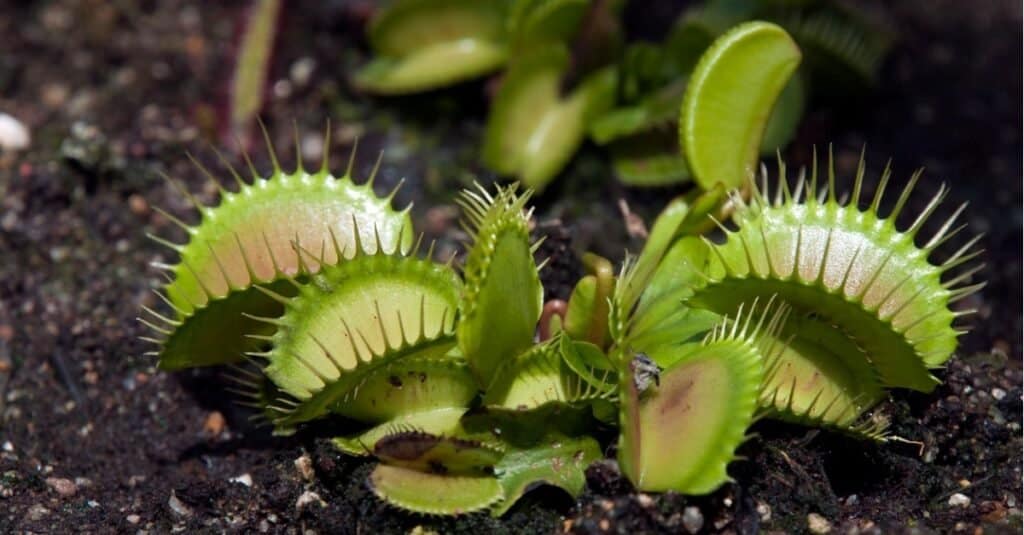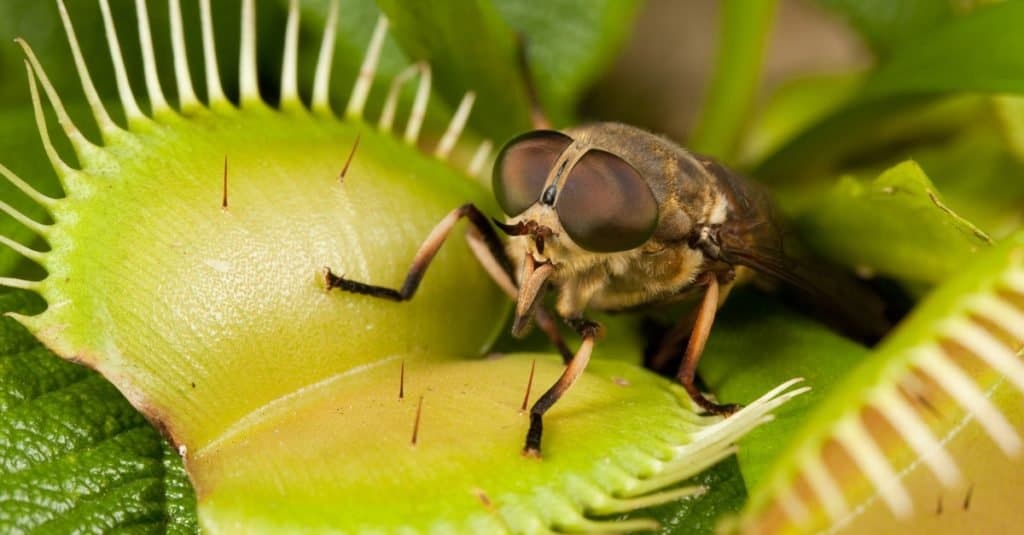The Venus flytrap is one of the most fascinating plants indigenous to the United States. After all, they are carnivorous, regularly consuming creatures that land on their traps. However, it’s worth considering which critters a Venus flytrap will eat and which ones it will not. For example, do Venus flytraps eat wasps?
Read on to discover whether or not the Venus flytrap could potentially overcome a wasp, turning it into a meal, or if this insect could fight its way out of the trap.

The Venus flytrap is one of the most fascinating plants indigenous to the United States.
©iStock.com/Karin de Mamiel
What Do Venus Flytraps Eat?
Venus flytraps consume a wide variety of foods including insects, arachnids, and a host of different arthropods. According to studies, ants are some of their most common prey. Spiders and crawling insects such as beetles are also commonly captured and eaten by this plant.
These ground-based critters are larger and offer more nutrition than smaller flying insects. Also, since the Venus flytrap uses a snap trap instead of a sticky trap like other carnivorous plants, flying insects may be harder to catch.
Some estimates claim that only 5% of a Venus flytrap’s prey are flying insects. That doesn’t mean that this plant has a small pool of prey. Plenty of ground-dwelling critters meet their demise at the hands of the Venus flytrap.
How Do Venus Flytraps Attract and Consume Prey?
Venus flytraps have an interesting trapping mechanism that helps them capture prey. Essentially, the trap portion of a Venus flytrap is a specialized leaf that is split into two separate lobes. The outer edges of each lobe are lined with additional projections called cilia that help the trap fold up neatly and catch prey as they struggle to escape.
Each lobe has three trigger hairs, two of which must be stimulated before the trap will close. That way, the Venus fly trap doesn’t accidentally close for something like a raindrop or miscellaneous debris.
Attracting prey is no small feat for the Venus flytrap. Insects, arachnids, and arthropods need a good reason to go to this plant. Scientists have discovered that Venus flytraps use a form of smell mimicry to attract and trick their prey into thinking that they are in the vicinity of fruits and flowers. By the time the insects realize that there is no sweet nectar waiting for them, it’s too late.

The “trap” of the Venus Flytrap is made of two hinged lobes at the end of each leaf. On the inner surfaces of the lobes are hair-like projections called trichomes that cause the lobes to snap shut when prey comes in contact with them.
©Linas T/Shutterstock.com
The victim will trigger the two required hairs to spring the trap. Once the trap starts to close, the prey triggers other hairs as well.
After the prey springs the trap, the two lobes fold together and form a seal. Next, the plant begins to secrete enzymes that will help digest its new meal. The process of digesting and absorbing the nutrients can take up to five days, and then it takes several more days for the lobes to reopen to start the process again.
Can a Venus Flytrap Eat Wasps?
Yes, Venus flytraps eat wasps but not very often. Although they are not a common food for the Venus flytrap, this plant can capture and eat wasps. Videos exist of Venus flytraps consuming wasps, and they don’t seem to put up more of a fight than any other flying insect that gets caught in the crosshairs of this carnivorous plant.
However, like most other flying insects, the wasp has an advantage. Flying insects can trigger the hairs and then fly away before they are closed in the trap. The wasp has to have just about all of its body inside of the trap before it springs. Then, they need to stay still while the trap starts to close. That way, by the time they realize something is wrong, it’s already over for them.
Once the trap closes, the wasp is stuck. Chewing or stinging the lobes for a reprieve doesn’t save the flying insect from its fate. Instead, the lobes will clasp together and begin the process of digesting the wasp.
Since the wasp is quite large compared to the ants and beetles that make up most of the Venus flytrap’s diet, it could take several days for the digestion process to be completed.
Is a Venus Flytrap a Plant or Animal?
The Venus flytrap is a plant. This organism comes from the Droseraceae family of carnivorous plants, and its binomial name is Dionaea muscipula. Although it may be confusing to see a plant take part in predation, that doesn’t necessarily mean the plant is animal-like.
The Venus flytrap does not obtain all of its energy from its prey, either. Instead, this creature also has parts that engage in photosynthesis, the typical method of energy production associated with plants. Another misconception is that this is the only carnivorous plant in the world.
Roughly 600 species of carnivorous plants exist in the world. Some of those species eat creatures considerably larger than ants, including small mammals. Pitcher plants are the largest carnivorous plants. They can measure up to 16 inches tall and contain as much as 9 gallons of fluid in their trap.
Some of the animals found in those traps include rats, lizards, birds, and frogs. That is a much larger type of prey than any the Venus flytrap could accommodate.
What Eats Venus Flytraps?
Venus flytraps are not immune to consumption. Several species of creatures feed on these plants including birds, squirrels, and raccoons. They are not a poisonous species, so they don’t have much protection against predation.
Predation is not the only threat facing these plants. Venus flytraps are often uprooted and removed from their natural habitat, taken home by plant lovers to raise, or with the hope of selling them to a nursery.
Venus flytraps are indigenous to the coastal regions of North Carolina and South Carolina.
Overall, the Venus flytrap is a captivating plant that capable of consuming a wide variety of insects, including wasps. However, far more wasps seem to escape the closing trap than are caught by it.
Up Next:
- Do Venus Fly Traps Eat Hornets?
- 8 Carnivorous Plants That Eat Bugs
- Watch This Crazy Video Of Venus Flytraps Eating Wasps
- Venus Flytrap Seeds: Grow Your Own Carnivorous Plant!
- What Do Venus Flytraps Eat? 5 Favorite Foods
The photo featured at the top of this post is © sawinimages/Shutterstock.com
Sources
- oup.com / Accessed November 17, 2022
- swf.gov / Accessed November 17, 2022
- nhm.ac.uk / Accessed November 17, 2022
- ncbi.nim.nih.gov / Accessed November 17, 2022
Thank you for reading! Have some feedback for us? Contact the AZ Animals editorial team.







